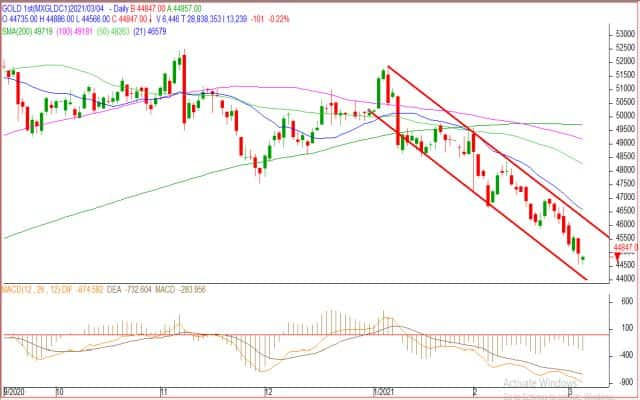



Gold prices slipped into the bear market territory on March 5 as surging US Treasury yields and a firm US dollar diminished the safe-haven appeal.
The precious metal has seen continued selling pressure in exchange-traded funds (ETFs) as it struggles to regain upward momentum. With growth outlook turning positive for the global economy and interest rate getting steady, investors have started exiting their positions and are diversifying their investments in search of better opportunity which has triggered a fall in the bullion prices.
Gold thrived during a period of uncertainty in the calendar year 2020 (CY2020), benefitting from the collapse of the global economy due to the shutdown caused by the coronavirus pandemic and hit a lifetime high of Rs 56,191 in August. It has since fallen in five out of seven months. The precious metal has given positive return only in October and December on hopes of a faster roll out of COVID-19 vaccine and ease off in restrictions in many countries spurred economic activity back on track.
Somasundaram PR, Managing Director, India, World Gold Council said, “Gold ETFs lost 2% of holdings in February as gold prices fell and rates rose. The global gold ETFs lost 84.7t in the process, marking outflows for the third time in four months, and the seventh worst historical monthly holdings loss. As such, global assets under management currently stand at 3,681 t, worth $207-billion – levels last seen in June 2020, when the price of gold was near the February closing level of $1,743/oz. Larger gold ETFs have lost assets in recent months, likely from momentum trading; while low-cost gold-backed ETFs continue to see assets grow. As real yields, particularly in the US, have spiked following the poor global market performance, they are lending tailwinds to gold prices. However, Asian gold ETFs holdings continue to grow assets despite other regions faltering.”
 Source: Gold.org/WGC
Source: Gold.org/WGC
“Like most asset classes, gold is being affected by the unprecedented economic and financial market conditions in play around the globe. We believe that recent volatility in the gold price has been driven by weak global signs, massive liquidations across all assets, and likely magnified by leveraged positions”, Somasundaram noted.
Gold holdings in SPDR Gold Trust, the world’s largest gold-backed exchange-traded fund, which hit the lifetime of 1,278.82 tonnes on September 21, 2020, have seen an outflow of 200.5 tonnes or 15.68 percent to 1.078.3 tonnes on March 4, 2021.

The 10-year US T-bond yield resumed uptrend and traded at 1.55 percent after hitting one year high of 1.61 percent in the last week of February. While the Dollar index crossed 92 marks for the first time since November 24, 2020.
“After having a dream run in 2020, the yellow metal has been falling for the past few months losing more than 20% in value from the highs witnessed in August 2020. The fall in gold prices in the domestic market is in line with the international market prices post comments of the US Fed Chairman on inflation and bond yield. Comex Gold prices fell due to the rising treasury yields that make holding gold more expensive, the strengthening of the dollar also makes gold buying expensive. Heavy outflows from Gold ETFs are also one of the reasons for the softness in Gold prices”, said Nish Bhatt, Founder & CEO, Millwood Kane International.
He further added, “We expect gold prices to remain sideways in the short-term as vaccination drive across the globe picks up the pace which will lead to full normalcy in economic activities. The expectation of a rise in inflation due to excess liquidity globally may help gold prices in the medium to long-term.”
A bear market is a condition during which prices of assets/securities come off 20 percent or more from their recent highs. The period generally suggests negative sentiment in an asset class sustained for over two months or more.
Sriram Iyer, Senior Research Analyst at Reliance Securities said, Gold prices are likely to head south and may touch Rs 44,000 initially and if that level is broken then the prices may go down towards Rs 42,250 level. US Federal Reserve Chair Jerome Powell repeated his pledge to keep credit loose and flowing until Americans are back to work, rebutting investors who have openly doubted he can stick to the promise once the pandemic passes and the economy surges on its own.
The momentum on bond rally indicates that yields may test levels close to 2 percent and this should be negative for gold and as rising yield will support Dollar index which will cause a kneejerk reaction for the bullion.
 Reliance Securities
Reliance Securities
The 50% Fibonacci retracement from the low of Rs 38,400 it touched in March last year and the high of Rs 56,191 in August comes around Rs 47,300 which was broken decisively on February 15 along with Death cross formation on simple moving average and exponential moving average have given confirmation of a major selloff in the gold prices. In dollar terms, gold has crucial support in the range of $1,685-$1,660, below which it may test the $1,600 level, said Iyer.
Concurring with Iyer’s view, Kshitij Purohit, Product Manager, Currency & Commodities, CapitalVia Global Research Limited said the bullion prices are likely to consolidate between $1,685-$1,660 on the COMEX and Rs 44,000-Rs 43,800 on the MCX. If the price breaks below 1,665 on COMEX and Rs 43,800 on MCX then further bearishness is expected and the price may touch Rs 42,000-Rs 41,500 levels on the downside. The other factor behind the fall is low demand and an increase in supply as gold miners’ production are back at a pre-COVID level.
“MCX Gold traded on a negative note in February and closed lower by 7.29% at Rs.45736 level as compared to January. Gold has been making lower tops and lower bottoms on the daily chart which indicates the weakness in the prices of the yellow metal. Going ahead, the metal is likely to continue to trade in a bearish trend. MCX Gold has got strong resistance at Rs 46,500 level while intermediate resistance is placed in the range of Rs 45,400-Rs 45,500. Any rise towards the intermediate resistance level is good selling opportunity in the metal. On the lower side, MCX gold is likely to move towards Rs 44,200 and Rs 43,500. Spot Gold has strong immediate support in the range of $1,645-$1,650, strong resistance is placed in the range of $1,775 - $1,780”, said Navneet Damani, Vice President, Motilal Oswal.
Sunand Subramaniam, Senior Research Associate, Choice Broking said, “We estimate international Gold futures to continue to trade bearish with an expectancy of a further rise in the 10-year bond yields in the US and other developed economies. Earlier last week, Joe Biden has released a $1.9 trillion coronavirus relief proposal, aimed at urgently combating the pandemic and economic crisis triggered with minimum wage of $15 per hour to the American citizen.”
Subramaniam expects a bearish trend for the coming weeks and recommends selling in MCX Gold April futures at Rs 44,800/10 gram for a target price of Rs 43,800 and maintaining a stop loss above Rs 45,200 on a closing basis.
MCX April Gold futures fell Rs 165, or 0.37 percent to trade at Rs 44,376 per 10 grams on Friday evening. While Spot gold was down by $3.26 to $1,694.17 per ounce at 1107 GMT in London trading.
For all commodities-related news, click here
Disclaimer: The views and investment tips expressed by experts on Moneycontrol.com are their own and not those of the website or its management. Moneycontrol.com advises users to check with certified experts before taking any investment decisions.
Discover the latest Business News, Sensex, and Nifty updates. Obtain Personal Finance insights, tax queries, and expert opinions on Moneycontrol or download the Moneycontrol App to stay updated!
Find the best of Al News in one place, specially curated for you every weekend.
Stay on top of the latest tech trends and biggest startup news.